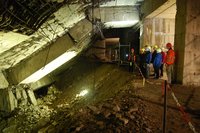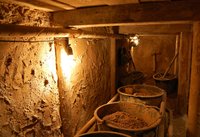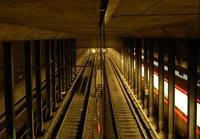The History of Berlin´s Underground
The Cold War in the Underground
Rubble Clearance and Reconstruction
A type of improvised urban life begins again amazingly quickly in the ruined landscape, which Berlin once was. After the end of the war, the main priority is to get the urban infrastructure operational again. Due to the risk of epidemics emanating from the flooded north-south tunnel, in which thousands were initially suspected to have died, reconstruction work begins at the direction of the Soviet City Commander in May 1945. After the damaged areas have been sealed, almost 1.9 million cubic metres of water are pumped out of the Berlin transport tunnels. In September 1945, the commuter train tunnels can be inspected with dinghies. 93 bodies and 102 train carriages are found in the sludge. However, it takes another 10 months until the train tunnel is cleared and restored to such an extent that the trains can once again stop in the underground stations of the north-south tunnel.
The clearance of the estimated 60-70 million cubic metres of rubble is another problem. The amount equates to a 30-metre-wide and 9- to 10-metre-high dam between Berlin and Hamburg. The debris is piled in rubble mountains in many places around the city.
An inventory of the damage reveals:
Of Berlin’s above-ground structures, around 30 per cent are completely destroyed, of the underground structures, just under 5 per cent. The city centre, however, has been hit especially hard with more than 80 per cent of pre-war buildings destroyed in places.
The Cold War and the Building of the Wall
As a result of the Berlin Blockade, Berlin’s urban infrastructure is gradually divided. Apart from the sewage system and the traffic tunnels, all lines between the two halves of the city are cut until 1952. As early as February, the pneumatic post is intercepted by East Berlin, so that “no subversive news from the western part reaches the democratic sector of Berlin”, according to the East Sector. A little later, the telephone lines are cut, and the separation of the gas, electricity and water supply is completed. Soon, the underground becomes the main setting for the Cold War.
In April 1956, the Soviets discover a roughly 450-metre-long spy tunnel operated by the British and American secret services in southern Berlin, which serves to tap and listen in on Soviet and East Berlin telephone lines and is known as “Operation Gold”. Just one year later, the East Berlin press uses the attempt by three West Berlin youths to reach the East Sector via the old heating tunnel of the Reichstag ruins as an opportunity to blame this action on the "USA voles".
With the building of the Wall in the night of August 12th to 13th, 1961, the underground transport network is also divided. The stations where subway lines go from West to West, as well as the commuter train tunnels under the Soviet sector, are cordoned off at short notice. Potsdamer Platz subway station (today on subway line 2) is also affected by this. Employees of the BVG (Berlin Transport Company) West and East are sitting together having a coffee in the operations rooms at around 11 p.m. Suddenly, armed police occupy the subway station and send the West Berliners home. Just a few weeks later, the tunnel to the West is completely walled up. The closing off of the sewers follows the escape tunnels. More than 70 of these projects are known but the majority – mostly because of betrayal – fail. Ever better surveillance technology, including listening devices to locate excavation noises, makes digging tunnels a life-threatening undertaking. At the beginning of 1972, three young East Berliners manage the last known tunnel escape.
For twelve nights, they dig from the basement of an old energy supply building on Leipziger Strasse under Zimmer Strasse, which has been designated the death strip, to Kreuzberg. At the first breakthrough, they come out in the middle of the barrier; the tunnel is two metres too short. However, the “Mole Company” remains undiscovered, the escapees dig on and luckily reach West Berlin. A short time later, a border patrol discovers the entry point in the basement during a routine inspection.
Transit Lines and Ghost Stations
After August 13th, 1961, no trains stop in many underground stations in the city centre. The exits are systematically barred or walled up. Only patrolmen of the border troops and the transport police move through this ghostly no man’s land. All stations in the north-south tunnel located below East Berlin, as well as the stations on today's subway lines 6 and 8, are closed. The West Berliners have to travel through the eastern part of the city without stopping. Only in the hermetically sealed subway and commuter train station of Friedrichstrasse, now a border crossing, is boarding and disembarking possible. A white stripe painted on the wall marks the underground border line in the tunnels. The transit lines and their “ghost stations” are an absurd special feature under the divided city. For their use, West Berlin pays an annual fee of several million Deutschmark. The closed stations can only be driven through at walking speed, monitored by the border soldiers or the transport police. Although the use of firearms in the tunnels is only allowed in the case of self-defence because of the fear of ricochet – at that time a closely guarded secret – a sophisticated security system should thwart any escape attempt.
“UTA” – State Security Investigations
In 1967, three forgotten tunnel systems from the plans for Germania are discovered in West Berlin under the Soviet monument on Strasse des 17. Juni. Rumours about possible underground connections to the eastern part of the city alarm the Ministry for State Security. Since there do not appear to be any old records of the demolition work, a secret and extensive investigation is subsequently commissioned. The aim is to identify “underground facilities” (Untertägige Anlagen – UTA for short) that could be used “for provocation and attacks on the state borders of the capital of the GDR”. In the years that follow, a total of 16 buried bunker facilities are reopened and documented, including the bunker facilities of the New Reich Chancellery. The "Führerbunker" is also reopened and meticulously measured and photographed after pumping out the infiltrated leachate. Old documents are even found in the sludge, including remnants of Goebbels’ diaries. The discovery disappears a little later in the shadowy corridors of State Security. The “Adlon Bunker” is also reopened, as well as the bunker facilities of various ministries of the Third Reich, but without any major surprises. In 1974, the State Security investigations come to a provisional close: secret connections in the western part of Berlin cannot be proven.
instagram takipçi satın al - instagram takipçi satın al mobil ödeme - takipçi satın al
bahis siteleri - deneme bonusu - casino siteleri
bahis siteleri - kaçak bahis - canlı bahis





